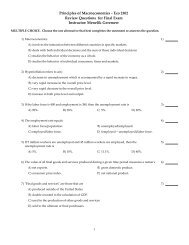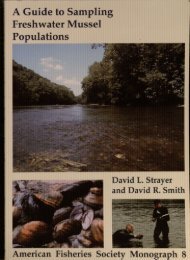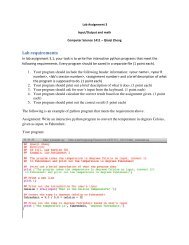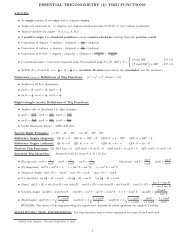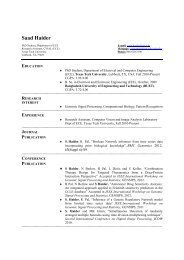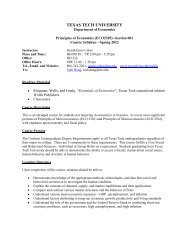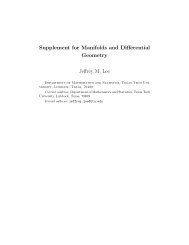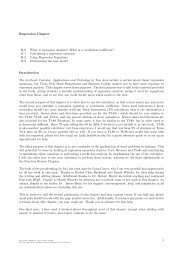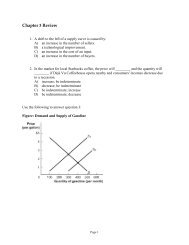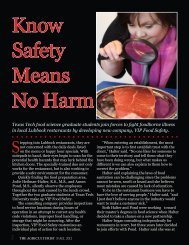Download - MyWeb - Texas Tech University
Download - MyWeb - Texas Tech University
Download - MyWeb - Texas Tech University
You also want an ePaper? Increase the reach of your titles
YUMPU automatically turns print PDFs into web optimized ePapers that Google loves.
The 2012 Season of the Chan Chich Archaeological Project<br />
The genesis of the idea to develop the database<br />
came from a rather informal experiment with<br />
an iPad in the field during the summer of 2011.<br />
I field tested an iPad 1 at La Milpa, Belize to<br />
explore the feasibility of using iPads to collect<br />
data in the field. My use of the iPad was limited<br />
to four specific tasks: (1) using the iPad as a<br />
field library with PDFs of previous field reports<br />
and relevant journal articles, (2) storing copies<br />
of digital photographs for quick reference in<br />
the field, (3) using Numbers, an Excel like<br />
spreadsheet app, to record my photolog (over<br />
750 photos were taken in the field on my<br />
camera alone), and (4) using iDraw, a technical<br />
drawing app, to draw three archaeological<br />
profiles in the field instead of on graph paper.<br />
The iPad performed exceptionally well. It was<br />
lightweight, had phenomenal battery life, and<br />
could even be used in light rain, much to my<br />
surprise. It rains frequently in the summers in<br />
Belize, and even a drizzle makes it impossible<br />
to use paper field forms. By placing the iPad<br />
in a waterproof plastic bag, it was possible to<br />
draw profile drawings and enter photolog data<br />
while all paper-based note taking was halted.<br />
Coincidentally, while in Belize in 2011, I<br />
learned that a colleague at the <strong>University</strong> of<br />
New Hampshire, Dr. Eleanor Harrison-Buck,<br />
was testing iPads on her project, as well. Her<br />
crews were using FileMaker Pro, a relational<br />
database, and its iPad counterpart in the field<br />
and reported generally positive reviews.<br />
The Data Collection System as<br />
Proposed<br />
The following is taken from the original grant<br />
proposal. As is often the case, the final product<br />
differed somewhat from the envisioned system:<br />
As currently envisioned, the data<br />
collection system will replace the<br />
hierarchy of field forms typically used<br />
in Maya archaeology. The backbone of<br />
the system will be a Filemaker Pro 11<br />
relational database, which will be stored<br />
on a MacBook Pro in the field laboratory.<br />
The laptop will be connected to an<br />
external hard drive to allow continuous<br />
backups. The database forms will be<br />
exported to three iPads, and data will be<br />
entered on the digital forms in the field<br />
using Filemaker Go for iPad. Wireless<br />
keyboards will facilitate entering long<br />
text descriptions. Each evening, the<br />
iPads will be synced with the laptop.<br />
In addition to excavation forms,<br />
the database will include photologs<br />
(running list of photographs taken on<br />
each camera) and laboratory analysis<br />
forms.<br />
Other data (profile and plan map<br />
drawings of excavations) will be<br />
entered using iDraw on the iPads.<br />
These drawings will be uploaded to<br />
the laptop each evening, and they will<br />
be finalized using a desktop version<br />
of the software. Photographs and<br />
videos will be uploaded and managed<br />
in iPhoto on the laptop. Copies of<br />
photos and videos will then be synced<br />
to the iPads as a reference source for<br />
use during the excavations. Similarly,<br />
data from the Total Data Station (a<br />
surveying instrument) will be uploaded<br />
to the laptop. Photographs and finalized<br />
drawings will be linked to the relevant<br />
field forms in the Filemaker Pro<br />
relational database, as will the results<br />
of laboratory analysis.<br />
The Data Collection System as<br />
Built and Implemented<br />
Over the course of several months in the<br />
spring of 2012, the FileMaker Pro 11 database<br />
evolved through multiple “alpha” and “beta”<br />
versions. Because neither Matthew Harris nor I<br />
had used FileMaker before, the learning curve<br />
74



